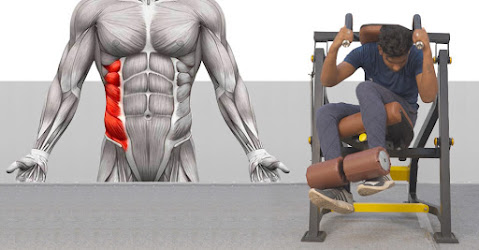 |
| Side abdominal exercise (Ref: https://excelfitindia.com/) |
The lateral abdominal muscles including transversus abdominis (TrA), internal oblique (IO), and external oblique (EO). All of the trunk muscles are considered to be important for the restoration of normal function and progression involves strategies for re-education of the whole muscle system.
Refer to the recent topic which talks about lateral abdominal and spine movement that indicated multi - muscle in one movement. Torso rotation is associated between the same IO side and opposite EO side. Torso side bending acts by the same side of IO and EO and TrA. Torso forward bending such as sit up is moved by EO anterior fibers, TrA, and rectus abdominis. Abdominal flattening is developed by TrA and EO.
 |
| Side bending exercise (Ref: http://www.jasestuart.com/) |
The second basic 10 of 20 therapeutic strengthening exercises to activate lateral abdominal muscle for low back pain (Remark: If you feel severe pain and any numbness or significant weakness, I would like to recommend you to stop exercising and observe the symptoms. And consult your physiotherapist or doctors.)
Each exercise needs 10 - 15 reps with 3 sets for 3 - 5 days a week. (Remark: Keep breathing during exercise for more efficiency because the diaphragm is a member of core stabilizer muscles.)
Exercise #11: Heel tap
Exercise #12: Quadrup spider
Exercise #13: Spider
Exercise #14: Lower torso rotate
Exercise #15: Upper torso rotate (Russian twist)
Exercise #16: Basic crunch
Exercise #17: Lateral crunch
Exercise #18: Rotation crunch
Exercise #19: Cross crunch
Exercise #20: Easy starfish crunch
A contemporary approach for LBP involves recruitment of TrA which contributes to lumbo-sacral stability by its role in intra-abdominal pressure, creating tension of thoraco-lumbar fascia, and compression of sacroiliac joints. It produces little force for trunk flexion, extension and lateral flexion. Despite its involvement in rotation of the trunk, it has only a small lever arm to produce rotational movement.
These exercise approaches need minimal activity about 2% - 3% of maximum voluntary contraction of the superficial abdominal muscles in the early stages of rehabilitation. To stimulate TrA activity based on evidence based practice contributes to spinal control and dysfunction of this muscle occurs in people with LBP.
 |
| Intra - abdominal pressure support low back spine (Ref: https://www.performancehealthcarepdx.com/) |
The recruitment of TrA is emphasized initially as abdominal hollowing (AH) maneuver or abdominal bracing has been presented as an activity which exercises the TrA muscle in an isolated fashion. It recruits OE with less activity of upper TrA, lower OI and RA. The technique involves inward movement of the lower abdominal wall without movement of the spine or pelvis.
In order to control the contraction of TrA during this maneuver, palpation of its tendon medial to anterior superior iliac spine, and also Pressure Biofeedback (PBF) have been used. The efficacy of this method has been established in randomized control trials with acute and chronic LBP patients.
 |
| Surface anatomy of core stabilizer muscle palpation at her index and middle finger where are above iliac crest. (Ref: https://depositphotos.com/) |
The 'curl-up' exercise in supine used to strengthen the abdominals, especially rectus abdominis, is a good example of this type of strengthening exercise. Producing a force or torque which can be used for specific movements is only one aspect of muscle function. It is similar to McGill that uses it to strengthen the EO majorly.
The pelvic tilting is likely to produce greater activity of middle OI relative to upper TrA and RA.
One musculature mechanism which involves stability is the production of tension in the lumbar dorsal fascia. Upper fascicles of TrA that attach to the rib cage are horizontal, and middle and lower fascicles that fuse with the thoracolumbar fascia and the iliac crest are inferomedial. Fibers of upper TrA are also active with the opposite direction of trunk rotation to lower and middle fibers, and activity of lower and upper fibers of OI vary during posterior pelvic tilting.
 |
| Left to right: TrA - IO - EO - Thoracolumbar fascia (Ref: https://www.crossroadsphysiotherapy.com/) |
The lumbar dorsal fascia is a noncontractile structure which provides considerable support to the lumbar area. Its contribution to stability is increased through the influence of muscle attachments. Tension in the fascia can be increased by contraction of the internal obliques and transverse abdominals which attach to the middle layer of the fascia. Tension is also increased between the middle and posterior layers of the fascia by the contraction of the paraspinal muscles. Although the lumbar dorsal fascia provides local protection fur the lumbar spine, it appears that increasing intra-abdominal pressure(IAP) could provide a more general mechanism for protection of the whole spine.
 |
| Ideal posture (Left) & Lower cross syndrome (Right) (Ref: https://evergreenclinic.ca/) |
Many muscles worked in synergistic groups and appeared to be specifically involved in mechanisms designed to stabilize, protect the lumbar spine and control neutral posture. For example, weakness of OE causes sway back posture which is thoracic behind the pelvic. Or Hyper lumbar lordosis posture because of TrA weakness.
You can watch more VIDEO on https://yimphysionearme.blogspot.com/2022/09/physiotherapy-with-9-of-18-basic.html and https://yimphysionearme.blogspot.com/2022/09/the-second-physiotherapy-with-9-of-18.html
Reference:
https://core.ac.uk/download/pdf/227985494.pdf
https://www.sciencedirect.com/science/article/pii/S0004951414605146
http://www.pnfchi.com/fotos/literatura/1233770497.pdf
https://d-nb.info/1114223050/34
Kendall FP., et al. Muscles testing and function. Fourth edition. Williams & Wiikins. USA.
1993.




ไม่มีความคิดเห็น:
แสดงความคิดเห็น